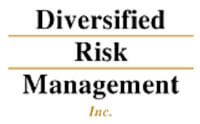Employee Drug Investigations
Employers should be concerned about the bottom-line impact of employee substance abuse in the workplace: increased absenteeism, decreased productivity, higher insurance costs, and additional liability-related expenses.
Small businesses, which employ over half of the nation’s workforce, are now a magnet for drug users. These companies can least afford the legal and business exposure associated with workplace substance abuse.
- 70% of the estimated 14.8 million Americans who use illegal drugs are employed1
- Drug overdoses killed roughly 64,000 people in the United States in 20162
- Workers with alcohol problems were 2.7 times more likely than workers without drinking problems to have injury-related absences3
- Daily marijuana use by adults (ages 19-22) is at the highest level since the early 1980s for this age group (7.8%), reaching the highest level seen for non-college youth (12.8%) and among the highest for full-time college students (4.9%)4
- An estimated 54 million people (more than 20 percent of those aged 12 and older) have used prescription medications for non-medical reasons at least once in their lifetime5
- Abuse of Over-the-Counter (OTC) drugs and opiates is on the rise READ MORE6
[1] https://www.ncadd.org/about-addiction/addiction-update/drugs-and-alcohol-in-the-workplace
[2] https://www.cdc.gov/nchs/nvss/vsrr/drug-overdose-data.htm
[3] https://www.ncadd.org/about-addiction/addiction-update/drugs-and-alcohol-in-the-workplace
[4] https://www.drugabuse.gov/news-events/news-releases/2017/09/young-adults-daily-use-marijuana-concern
[5] https://www.drugabuse.gov/publications/research-reports/misuse-prescription-drugs/what-scope-prescription-drug- misuse
[6] https://diversifiedriskmanagement.com/blog/pain-killers-and-heroin-in-the-workplace
At some point, employee substance abuse may compel you to conduct an investigation.
Employers often use independent third-party investigation firms to conduct the investigation. This is an unbiased approach to the suspected substance abuse amongst employees in the workplace. If the investigators discover the alleged problem exists, they document the misconduct with detailed reports. This allows the employer to take appropriate disciplinary and corrective action and to defend themselves against most litigious claims should any arise, post-investigation.
Upon learning of potential drug issues, most employers are tempted to announce the company has a “zero tolerance” for drugs and alcohol in the workplace. Employers should be aware however that the employer’s substance abuse policy must be updated to reflect current guidelines in this area as it pertains to employment law.
Undercover Investigations
There are more effective ways to approach employee substance abuse. For example, undercover investigators can be placed into the workforce inconspicuously, blending effortlessly and seamlessly into the fabric of your own corporate demographics and culture.
If the investigation is supervised by your legal counsel, under the direction and umbrella of the attorney-client privilege, the findings of the investigation can usually be sheltered from unwanted third-party scrutiny. At all times, the client and attorney are in charge of the length and breadth of the investigation, and the communication between them and the investigators should be frequent.
Visual Aids for Employers
In this article we will review current trends in marijuana use, new forms of ingesting marijuana and its active chemicals, changes in marijuana slang and paraphernalia, and provide visual examples to assist employers in keeping these items out of the workplace.
As marijuana continues to become decriminalized, more and more buying options are being offered to consumers.
Marijuana
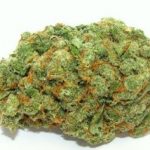 First, old fashioned marijuana is now called “flower.” This new slang term came about because there are now several different forms of ingesting marijuana and its active chemicals.
First, old fashioned marijuana is now called “flower.” This new slang term came about because there are now several different forms of ingesting marijuana and its active chemicals.
Usually this weed is a mixture of green, brown or orange dried, leaves, stems, and flowers, often called “buds.”
Marijuana Edibles
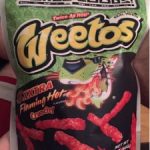
Unlike smoking marijuana, where cannabinoids enter the body through the lungs, edibles introduce cannabinoids through the gastrointestinal tract. As medical marijuana has grown in popularity, more and more buying options are being offered to consumers.
There are now marijuana-laced cookies, candies, chips, drinks, cereals, and even pizza. In the past, the most common slang names for marijuana-laced foods were “brownies” and “space cake.” Edibles present a unique challenge to employers, as employees can be sitting in the break room “getting high” in plain sight. Look for labels that mention dosage levels of THC in milligrams.
Keep an eye out for look-alike brands, like the real example below: a popular brand of chips which has been parodied for edible marijuana-laced chips.
Vaporizers/Vapes
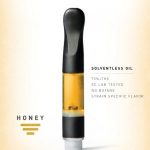 Vape pens, also referred to as vaporizer pens, vapor pens or vape pen mods are tiny pen-shaped vaporizers. Originally vape pens were made to look like vaporizer cigarettes that provide nicotine to users. Now they can be used to smoke “Wax” and “Oil.”
Vape pens, also referred to as vaporizer pens, vapor pens or vape pen mods are tiny pen-shaped vaporizers. Originally vape pens were made to look like vaporizer cigarettes that provide nicotine to users. Now they can be used to smoke “Wax” and “Oil.”
Vaporizer pens are typically powered by a small battery that screws onto a tank or atomizer that contains a heating coil system. The vaporizer pen is then filled up with THC-containing wax or oil and when the button is pressed, the battery engages the coil and vapor is created, which is inhaled by the user (this is referred to as “vaping”).
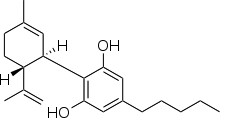
Cannabidiol (CBD) is one of at least 113 active cannabinoids identified in cannabis. It is a major phytocannabinoid. CBD is considered to have a wide scope of potential medical applications – due to clinical reports showing the lack of side effects, particularly a lack of psychoactivity (as is typically associated with ∆9-THC), and non-interference with several psychomotor learning and psychological functions.
Vape pens have disposable cartridges containing CBD oils, some of which are flavored. This allows the user to purchase new cartridges without replacing the entire vaporizer. Keep an eye open for these in the employee parking lot.
Dabbing
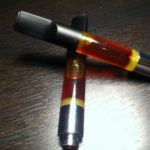 We will now move onto a new trend: Dabbing
We will now move onto a new trend: Dabbing
“Dabbing” is a new method for smoking marijuana concentrates that involves using either a blow torch or electric nail to heat the surface of an oil “rig” pipe or bong and pressing a cannabis concentrate such as hash oil against the heated surface, thereby creating a powerful smoke.
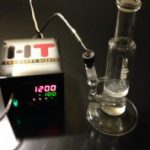
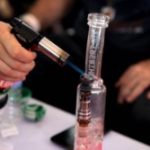
A dab rigs looks like a glass bong but it is a specifically designed glass pipe for dabbing. The biggest difference between a bong and a “dab rig” is the material that is smoked. A bong is used to smoke dry marijuana leaves and buds that are packed into a bowl and lit with a lighter.
A dab rig is used to smoke oil, shatter, wax or other concentrates that are pressed against the bowl. The bowl is super hot, via connection to an electric nail or by heating with a handheld butane torch, which vaporizes the concentrate on contact, before it is inhaled.
What do you “dab” in a “dab rig”? Cannabis concentrates: oils and waxes containing THC or CBD.
Cannabis Wax
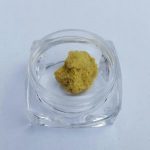
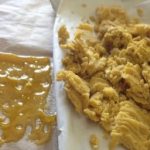 Cannabis wax refers to the softer, opaque oils that have lost their transparency after extraction. Unlike those of transparent oils, the molecules of cannabis wax crystallize as a result of agitation.
Cannabis wax refers to the softer, opaque oils that have lost their transparency after extraction. Unlike those of transparent oils, the molecules of cannabis wax crystallize as a result of agitation.
Light can’t travel through irregular molecular densities, and that refraction leaves us with a solid, non-transparent oil. Sometimes referred to as “budder.”
Wax is usually sold in small clear plastic containers.
Hash Oil
 Hash oil is an oleoresin obtained by extraction from marijuana and/or hashish.
Hash oil is an oleoresin obtained by extraction from marijuana and/or hashish.
Oils are usually packaged in folded paper because they are delicate and sticky.
Shatter Extract
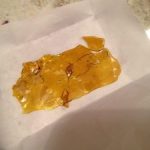
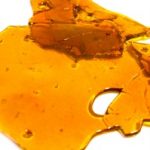 “Shatter” is a semi-translucent amber-colored extract. It is called “shatter because it resembles glass when broken into pieces for use.
“Shatter” is a semi-translucent amber-colored extract. It is called “shatter because it resembles glass when broken into pieces for use.
This is a heavier-hitting high which turns weed into a concentrate that packs up to 80 percent cannabinoid content.
Shatter is one form of dabs, marijuana concentrates produced by extracting cannabinoids, the plant’s psychoactive chemicals THC and CBD.
Hash and Hashish
 “Hash”, also called “hashish” is the resin collected from the flowers of the cannabis plant. The primary active substance is THC. “Hash” has been smoked for centuries and was part of the 1960’s counter-culture in the U.S. It is still popular and is now being mixed with marijuana and other drugs to create powerful concoctions.
“Hash”, also called “hashish” is the resin collected from the flowers of the cannabis plant. The primary active substance is THC. “Hash” has been smoked for centuries and was part of the 1960’s counter-culture in the U.S. It is still popular and is now being mixed with marijuana and other drugs to create powerful concoctions.
Kief
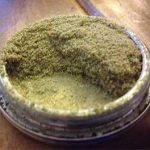 The slang term “Kief’ refers to resinous trichomes of cannabis that may accumulate in containers or be sifted from loose, dry cannabis flower with a mesh screen or sieve.
The slang term “Kief’ refers to resinous trichomes of cannabis that may accumulate in containers or be sifted from loose, dry cannabis flower with a mesh screen or sieve.
Kief usually comes from using a grinder to grind up marijuana and accumulates at the bottom of the grinder, beneath a mesh screen.
Moon Rocks
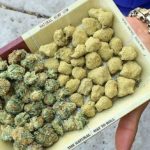 “Moon rocks” is marijuana that is coated in hash oil and then rolled in kief , creating a very strong and potent drug. They look like sand-coated balls or rocks.
“Moon rocks” is marijuana that is coated in hash oil and then rolled in kief , creating a very strong and potent drug. They look like sand-coated balls or rocks.
Hopefully these images and slang terms will help you identify drug abuse in the workplace and keep these items off your property.
